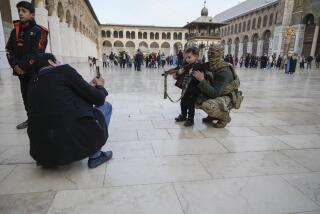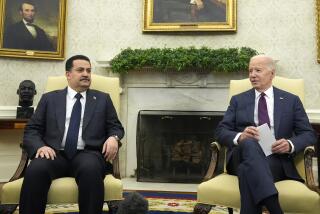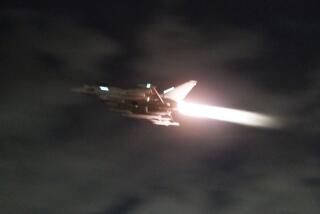U.S. levels new charges against Iran
BAGHDAD — The U.S. military on Wednesday renewed its accusations that Iran is providing arms, training and other unspecified “support” to Shiite and Sunni Muslim factions in this country’s ongoing civil war.
Meanwhile, violence in Baghdad continued today with the bombing of a bridge that resulted in at least 10 deaths, authorities said.
Police said a truck loaded with explosives blew up on the Sarafiya bridge shortly after 7 a.m., severing the middle portion of the iron-frame structure. Witnesses said at least five cars tumbled into the Tigris River, and a search began for additional victims. The bridge, one of 10 that span the river as it winds through the capital, was built 70 years ago.
The accusations against Iran were leveled by top-ranking spokesman Maj. Gen. William B. Caldwell IV at his weekly news briefing, and were based on recent raids that he said uncovered weapons bearing Iranian markings and dates that suggested they were delivered after the fall of Saddam Hussein.
The charges could fuel U.S.-Iranian tensions already inflamed by the Islamic Republic’s announcement this week that it has begun manufacturing “industrial” quantities of atomic fuel in violation of a United Nations resolution. Last week, the Iranians ended a nearly two-week standoff with Britain by releasing 15 British sailors and marines they had seized in a disputed area of the Persian Gulf.
Caldwell’s assertions came as hopes faded for a U.S.-Iranian rapprochement in the aftermath of an Iraqi security conference that drew 17 delegations to Baghdad in March. U.S., Iranian and Iraqi representatives sat down in a rare effort to try to iron out their differences. Observers described the meeting as cordial but tense.
Previous charges that Iranian leaders were providing arms and training to Iraqi militants were denied by Tehran. U.S. critics of President Bush said those charges were part of a campaign to pave the way for an invasion, much as allegations that Hussein had stockpiled weapons of mass destruction preceded the U.S.-led invasion of Iraq in March 2003.
But two academics who have criticized Bush policy say Iran, a predominantly Shiite nation, probably is hedging its bets with aid to various militant factions in Iraq.
“The goal of the Iranians is to be the dominant player in Iraq after the Americans have gone. By getting us out, and with enough ties to people who will be in power, they are guaranteeing their role,” said Gregory Gause, director of Middle East studies at the University of Vermont.
Michael O’Hanlon, a senior fellow at the Brookings Institution in Washington, said he doubted that the Bush administration was repeating charges of Iranian interference to justify another invasion.
“As much as I tend to criticize the Bush administration, the claim that they are preparing for another invasion doesn’t begin to hold water to a strategist.... We don’t have the forces.... We don’t have the rationale,” O’Hanlon said.
In mid-February, Bush and Maj. Gen. Caldwell both distanced themselves from assertions made that month by unnamed U.S. officials that Iranian government leaders had ordered the aid to militant groups. Bush instead blamed elements of the Iranian armed forces.
On Wednesday, Caldwell said Shiite militiamen had received training this month at undisclosed locations in Iran. Asked whether the Iranian government had conducted the training, Caldwell responded that “Iranian intelligence surrogates” had been responsible.
Caldwell and ordnance specialist Maj. Martin Weber also showed reporters a cache of a dozen mortar rounds, rockets and rocket-propelled grenades found in Baghdad on Monday. Their design and markings indicated they were manufactured either in Iran or China, and were painted over with Iranian stenciling, the officials said. They added that the weapons were similar to those used by Hezbollah, an Iranian-sponsored Islamic militant organization in Lebanon.
The cache, which was seized based on a citizen tip, also bore the years 2005 and 2006, referring to when they were made, Weber said. If those dates are accurate, they indicate that the arms could not have been part of weapons stockpiled before Hussein’s overthrow in April 2003.
The arms were part of what Caldwell said was a 50% increase in the number of weapons seizures since February, to an average of 36 per week. He attributed the rise to improved military-citizen cooperation since U.S. and Iraqi forces began implementing a Baghdad security plan that month that includes more troop presence in neighborhoods.
Caldwell said Iran was helping both sides in the sectarian conflict. “We have found cases where Iranian intelligence services are giving Sunni insurgents some support,” he said, declining to elaborate.
The U.S. had asserted that Iran was helping Iraqi Shiite militias with arms training, notably in the assembly of lethal explosive devices that can penetrate heavily armored tanks.
Syria is also providing aid to the insurgency, Caldwell said. Two of 14 insurgents detained over the weekend in a Baghdad sweep said during interrogation that they had received training in Syria, he said. Moreover, he added, the government in Damascus has been allowing 40 to 60 insurgents a month to cross into Iraq.
“Death and violence are bad enough without outside interference,” Caldwell said.
The charges were made as the U.S.-Iraqi security crackdown in Baghdad was about to enter its third month. The U.S. is deploying an additional 21,500 troops to Baghdad and other areas as part of the plan to quell sectarian violence. Caldwell said the results so far had been mixed at best, with violence in the capital down but the number of deaths rising elsewhere.
Statistics indicate that the surge in troops has done little to stem suicide bombings and civilian deaths. Instead, it has pushed them outside Baghdad. Caldwell said that more concrete results wouldn’t be measured until the final deployment of troops by the end of May.
Two-thirds of all casualties in Iraq last month were civilians, whereas 14% were coalition forces and 19% Iraqi security forces, Caldwell said.
The U.S. military on Wednesday reported the deaths of two more soldiers, victims of attacks in Baghdad on Tuesday and Wednesday. The fatalities brought the U.S. military death toll to 3,294 since the war began four years ago, according to icasualties.org a website that tracks military and civilian casualties. In addition, the bodies of 16 Iraqi civilians were found in the Baghdad area, all thought to be the victims of sectarian death squads.
Meanwhile, police reported the assassination of the projects director of the Ministry of Electricity, Abdul Abas Hashim, who was slain along with his driver early Wednesday. The official had received threats before.
*
Times staff writer Tina Susman in Baghdad contributed to this report.
More to Read
Sign up for Essential California
The most important California stories and recommendations in your inbox every morning.
You may occasionally receive promotional content from the Los Angeles Times.










